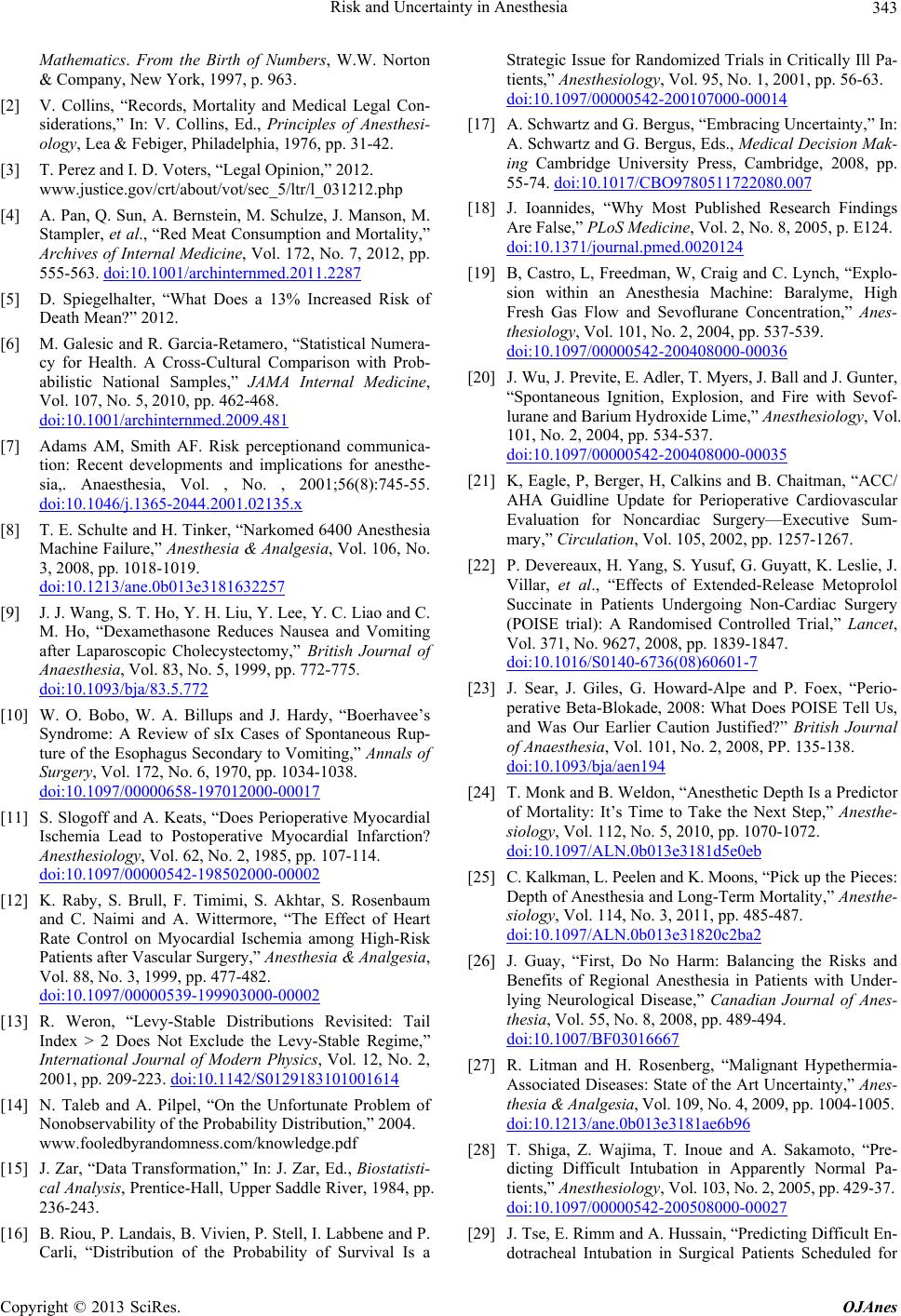
Risk and Uncertainty in Anesthesia 343
Mathematics. From the Birth of Numbers, W.W. Norton
& Company, New York, 1997, p. 963.
[2] V. Collins, “Records, Mortality and Medical Legal Con-
siderations,” In: V. Collins, Ed., Principles of Anesthesi-
ology, Lea & Febiger, Philadelphia, 1976, pp. 31-42.
[3] T. Perez and I. D. Voters, “Legal Opinion,” 2012.
www.justice.gov/crt/about/vot/sec_5/ltr/l_031212.php
[4] A. Pan, Q. Sun, A. Bernstein, M. Schulze, J. Ma nson, M.
Stampler, et al., “Red Meat Consumption and Mortality,”
Archives of Internal Medicine, Vol. 172, No. 7, 2012, pp.
555-563. doi:10.1001/archinternmed.2011.2287
[5] D. Spiegelhalter, “What Does a 13% Increased Risk of
Death Mean?” 2012.
[6] M. Galesic and R. Garcia-Retamero, “Statistical Numera-
cy for Health. A Cross-Cultural Comparison with Prob-
abilistic National Samples,” JAMA Internal Medicine,
Vol. 107, No. 5, 2010, pp. 462-468.
doi:10.1001/archinternmed.2009.481
[7] Adams AM, Smith AF. Risk perceptionand communica-
tion: Recent developments and implications for anesthe-
sia,. Anaesthesia, Vol. , No. , 2001;56(8):745-55.
doi:10.1046/j.1365-2044.2001.02135.x
[8] T. E. Schulte and H. Tinker, “Narkomed 6400 Anesthesia
Machine Fa ilure,” Anesthesia & Analgesia, Vol. 106, No.
3, 2008, pp. 1018-1019.
doi:10.1213/ane.0b013e3181632257
[9] J. J. Wang, S. T. Ho, Y. H. Liu, Y. Lee, Y. C. Liao and C.
M. Ho, “Dexamethasone Reduces Nausea and Vomiting
after Laparoscopic Cholecystectomy,” British Journal of
Anaesthesia, Vol. 83, No. 5, 1999, pp. 772-775.
doi:10.1093/bja/83.5.772
[10] W. O. Bobo, W. A. Billups and J. Hardy, “Boerhavee’s
Syndrome: A Review of sIx Cases of Spontaneous Rup-
ture of the Esophagus Secondary to Vomiting,” Annals of
Surgery, Vol. 172, No. 6, 1970, pp. 1034-1038.
doi:10.1097/00000658-197012000-00017
[11] S. Slogoff and A. Keats, “Does Perioperative Myocardial
Ischemia Lead to Postoperative Myocardial Infarction?
Anesthesiology, Vol. 62, No. 2, 1985, pp. 107-114.
doi:10.1097/00000542-198502000-00002
[12] K. Raby, S. Brull, F. Timimi, S. Akhtar, S. Rosenbaum
and C. Naimi and A. Wittermore, “The Effect of Heart
Rate Control on Myocardial Ischemia among High-Risk
Patients after Vascular Surgery,” Anesthesia & Analgesia,
Vol. 88, No. 3, 1999, pp. 477-482.
doi:10.1097/00000539-199903000-00002
[13] R. Weron, “Levy-Stable Distributions Revisited: Tail
Index > 2 Does Not Exclude the Levy-Stable Regime,”
International Journal of Modern Physics, Vol. 12, No. 2,
2001, pp. 209-223. doi:10.1142/S0129183101001614
[14] N. Taleb and A. Pilpel, “On the Unfortunate Problem of
Nonobservability of the Probability Distribution,” 2004.
www.fooledbyrandomness.com/knowledge.pdf
[15] J. Zar, “Data Transformation,” In: J. Zar, Ed., Biostatisti-
cal Analysis, Prentice-Hall, Upper Saddle River, 1984, pp.
236-243.
[16] B. Riou, P. Landais, B. Vivien, P. Stell, I. Labbene and P.
Carli, “Distribution of the Probability of Survival Is a
Strategic Issue for Randomized Trials in Critically Ill Pa-
tients,” Anesthesiology, Vol. 95, No. 1, 2001, pp. 56-63.
doi:10.1097/00000542-200107000-00014
[17] A. Schwartz and G. Bergus, “Embracing Uncertainty, ” In:
A. Schwartz and G. Bergus, Eds., Medical Decision Mak-
ing Cambridge University Press, Cambridge, 2008, pp.
55-74. doi:10.1017/CBO9780511722080.007
[18] J. Ioannides, “Why Most Published Research Findings
Are False,” PLoS Medicine, Vol. 2, No. 8, 2005, p. E124.
doi:10.1371/journal.pmed.0020124
[19] B, Castro, L, Freedman, W, Craig and C. Lynch, “Explo-
sion within an Anesthesia Machine: Baralyme, High
Fresh Gas Flow and Sevoflurane Concentration,” Anes-
thesiology, Vol. 101, No. 2, 2004, pp. 537-539.
doi:10.1097/00000542-200408000-00036
[20] J. W u , J. Previ te, E. Adler, T. Myers, J. Bal l and J . G u nter ,
“Spontaneous Ignition, Explosion, and Fire with Sevof-
lurane and Barium Hydroxide Lime,” Anesthesiology, Vol.
101, No. 2, 2004, pp. 534-537.
doi:10.1097/00000542-200408000-00035
[21] K, Eagle, P, Berger, H, Calkins and B. Chaitman, “ACC/
AHA Guidline Update for Perioperative Cardiovascular
Evaluation for Noncardiac Surgery—Executive Sum-
mary,” Circulation, Vol. 105, 2002, pp. 1257-1267.
[22] P. Devereaux, H. Yang, S. Yusuf, G. Guyatt, K. Leslie, J.
Villar, et al., “Effects of Extended-Release Metoprolol
Succinate in Patients Undergoing Non-Cardiac Surgery
(POISE trial): A Randomised Controlled Trial,” Lancet,
Vol. 371, No. 9627, 2008, pp. 1839-1847.
doi:10.1016/S0140-6736(08)60601-7
[23] J. Sear, J. Giles, G. Howard-Alpe and P. Foex, “Perio-
perative Beta-Blokade, 2008: What Does POISE Tell Us,
and Was Our Earlier Caution Justified?” British Journal
of Anaesthesia, Vol. 101, No. 2, 2008, PP. 135-138.
doi:10.1093/bja/aen194
[24] T. Monk and B. Weldon, “Anesthetic Depth Is a Predictor
of Mortality: It’s Time to Take the Next Step,” Anesthe-
siology, Vol. 112, No. 5, 2010, pp. 1070-1072.
doi:10.1097/ALN.0b013e3181d5e0eb
[25] C. Kalkman, L. Peelen and K. Moons, “Pick up the Pieces:
Depth of Anesthesia and Long-Term Mortality,” Anesthe-
siology, Vol. 114, No. 3, 2011, pp. 485-487.
doi:10.1097/ALN.0b013e31820c2ba2
[26] J. Guay, “First, Do No Harm: Balancing the Risks and
Benefits of Regional Anesthesia in Patients with Under-
lying Neurological Disease,” Canadian Journal of Anes-
thesia, Vol. 55, No. 8, 2008, pp. 489-494.
doi:10.1007/BF03016667
[27] R. Litman and H. Rosenberg, “Malignant Hypethermia-
Associated Diseases: State of the Art Uncertainty,” Anes-
thesia & Analgesia, Vol. 109, No. 4, 2009, pp. 1004-1005.
doi:10.1213/ane.0b013e3181ae6b96
[28] T. Shiga, Z. Wajima, T. Inoue and A. Sakamoto, “Pre-
dicting Difficult Intubation in Apparently Normal Pa-
tients,” Anesthesiology, Vol. 103, No. 2, 2005, pp. 429-37.
doi:10.1097/00000542-200508000-00027
[29] J. Tse, E. Rimm and A. Hussain, “Predicting Difficult En-
dotracheal Intubation in Surgical Patients Scheduled for
Copyright © 2013 SciRes. OJAnes